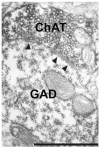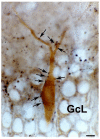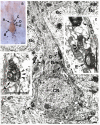Extrinsic afferent systems to the dentate gyrus
- PMID: 17765712
- PMCID: PMC1989689
- DOI: 10.1016/S0079-6123(07)63004-0
Extrinsic afferent systems to the dentate gyrus
Abstract
The dentate gyrus is the first stage of the intrahippocampal, excitatory, trisynaptic loop, and a primary target of the majority of entorhinal afferents that terminate in a laminar fashion on granule cell dendrites and carry sensory information of multiple modalities about the external world. The electric activity of the trisynaptic pathway is controlled mainly by different types of local, GABAergic interneurons, and subcortical and commissural afferents. In this chapter we will outline the origin and postsynaptic targets in the dentate gyrus of chemically identified subcortical inputs. These systems are afferents originating from the medial septum/diagonal band of Broca GABAergic and cholinergic neurons, neurochemically distinct types of neurons located in the supramammillary area, serotonergic fibers from the median raphe, noradrenergic afferents from the pontine nucleus, locus ceruleus, dopamine axons originating in the ventral tegmental area, and the commissural projection system. Because of the physiological implications, these afferents are discussed in the context of the glutamatergic innervation of the dentate gyrus. One common feature of the extrinsic dentate afferent systems is that they originate from a relatively small number of neurons. However, the majority of these afferents are able to exert a powerful control over the electrical activity of the hippocampus. This strong influence is due to the fact that the majority of the extrinsic afferents terminate on a relatively small, but specific, populations of neurons that are able to control large areas of the hippocampal formation.
Figures






References
-
- Aihara Y, Mashima H, Onda H, Hisano S, Kasuya H, Hori T, Yamada S, Tomura H, Yamada Y, Inoue I, Kojima I, Takeda J. Molecular cloning of a novel brain-type Na(+)-dependent inorganic phosphate cotransporter. J. Neurochem. 2000;74(6):2622–2625. - PubMed
-
- Alreja M. Excitatory actions of serotonin on GABAergic neurons of the medial septum diagonal band of Broca. Synapse. 1966;22:15–27. - PubMed
-
- Amaral DG. A Golgi study of cell types in the hilar region of the hippocampus in the rat. J Comp Neurol. 1978;182:851–914. - PubMed
-
- Amaral DG, Cowan WM. Subcortical afferents to the hippocampal formation in the monkey. J. Camp. Neurol. 1980;189:573–591. - PubMed
-
- Amaral DG, Witter MP. The three-dimensional organization of the hippocampal formation: a review of anatomical data. Neuroscience. 1989;31:571–591. - PubMed
Publication types
MeSH terms
Substances
Grants and funding
LinkOut - more resources
Full Text Sources

